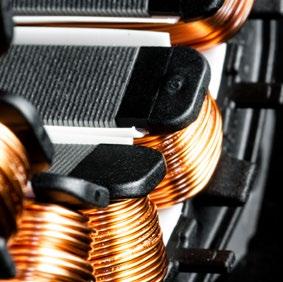
6 minute read
Industry Reputation-Building
Over the course of ICA’s current strategic plan, the Industry Reputation-Building (IRB) Team’s objective has been to increase the reputation of the copper industry in a measurable fashion. To reach this goal, the IRB Team focused its outreach and communications on a limited number of themes via collaboration-oriented, online campaigns and events in 2021.
While the burden of the pandemic continued to constrain IRB’s ability to engage partners and stakeholders in person, the IRB program sustained communications throughout 2021 by concentrating on timely and informative initiatives.
Advertisement
• THE CIRCULARITY OF COPPER: the Circular Copper Campaign showcased ICA members’ contributions to the circular economy and copper’s role in creating a culture of sustainability— without waste. The campaign tripled the average amount of time visitors spent on the ICA website.
In addition, an interactive LinkedIn Live event featured nearly 200 attendees.
• THE ROLE OF COPPER IN SUSTAINABLE INFRASTRUCTURE: the Infrastructure Reimagined
Campaign asked stakeholders from prominent organizations (e.g., the International Energy Agency) and governments around the world (e.g., U.S. Congress) to imagine the infrastructure of the future.
Their responses were recorded on video, shared online and viewed more than half a million times across platforms. The campaign also featured an interactive infographic highlighting the role of copper “behind the scenes” in transportation, home and office, and industry and the power grid.
The complete infographic can be found here.
• THE RESPONSIBLE PRODUCTION OF COPPER: grounded in member case studies, the Responsible
Copper Campaign shared infographics, social content and editorials centering on five topical issues, each illustrating the industry’s efforts to improve performance toward reaching the UN Sustainable
Development Goals (SDGs): mining, climate, environment, social responsibility and innovation. As part of the campaign, an op-ed discussing mining misconceptions was published on ICA’s VP of
Public Affairs LinkedIn page. The article has proven to be ICA’s most popular op-ed on LinkedIn, with an above average engagement rate.
These communications campaigns were developed in collaboration with ICA members and other ICA programs, specifically, the Material Stewardship (MS), Clean Energy Transition (CET) and Green & Healthy Buildings (GHB) teams. In addition, to guarantee relevance, content development was closely coordinated across regions to ensure all required nuances were captured in subsequent communications.

Another key component of IRB efforts in 2021 included participation in external events. ICA continued sponsoring events such as Climate Week NYC and GreenBiz to reach target stakeholder audiences. Additionally, these events gave ICA the opportunity to highlight staff expertise in specific areas and reach a greater number of stakeholders because organizations such as The Climate Group enjoy a larger social media and online presence.
Based on IRB’s success working with outside organizations in planning and hosting online events in 2020, ICA decided to serve as solo host of two LinkedIn Live events in 2021, both rooted in the circular economy—Circular Copper, and Industrial Symbiosis. These events not only expanded our relationships with members companies, but they enabled ICA to connect with critical stakeholders such as the World Resources Institute and the European Commission.
The importance of expanding ICA’s network can be seen in another critical piece of ICA’s advocacy strategy: the development and nurturing of partnerships and collaborations. 2021 saw IRB joining with IWCC to create messaging on the circular economy, highlighting the importance of the complete value chain, as well as assisting Global Partnerships on efforts such as United for Efficiency and the Cornerstone of Rural Electrification (CORE). Relationships such as these enable IRB to reach the objective of improving the copper industry’s reputation.
A critical vehicle for maintaining a strong reputation is a well-designed and functional website. Over the last year, IRB undertook the task of combining three websites into one. The best features and content from sustainablecopper.org and copperalliance.eu were merged into an optimized copperalliance.org. This new and improved website allows ICA to share content in a more engaging manner through better use of video, infographics and images. For example, viewers can not only learn where ICA members stand on the EU Green Deal, but they can also learn how copper drives infrastructure and smart-building design around the globe.
With the experiences of 2021 in the rearview mirror, the IRB team is poised to build on the success and strengthen the industry’s reputation in 2022.

Material Stewardship
REGULATORY OUTLOOK
The shift by governments from short-term economic stimulus packages in late 2020 to broad sustainability policies, initiatives and regulations addressing, for example, climate impacts, biodiversity loss and circularity, intensified in 2021 across all regions.
The European Union via the Green Deal has continued to scale-up their sustainability agenda. This has presented challenges for the copper industry but also opportunities for ICA to demonstrate the contribution of copper to circularity, to advocate for third-party voluntary initiatives like the Copper Mark to be recognized within proposed regulations on batteries and End-of-Life Vehicles, and to present ICA-funded, independent scientific research demonstrating the safe use of copper in the workplace and the environment.
Ambitious sustainability initiatives are also reflected in China’s 14th Five-Year Plan, which has a strong focus on green development, decarbonization, and supply chain security, i.e., copper availability and recycling. In addition, the China Nonferrous Metals Industry Association publicly announced that establishing a responsible sourcing scheme is in their work plan.
The U.S. passed the Bipartisan Infrastructure Deal, which includes requirements for green transportation, and a number of carbon concepts were introduced at local, state, and federal levels. One of the most notable being Executive Order 14057, which outlines a path to achieve net-zero emissions from federal procurement by 2050 while increasing the sustainability of federal supply chains.
From a Material Stewardship (MS) perspective, this has translated into an increase in the urgency and scope of challenges and opportunities relating to chemicals management and sustainability. MS Council members and staff continue to focus on continued access to markets and to position copper as a sustainable, responsibly produced metal, while navigating the increased awareness and scrutiny around the broad sustainability of materials.
MS PROGRAM
2021 was another productive year for the MS program, despite continued restrictions on in-person meetings and travel due to the ongoing pandemic. This productivity has ensured that the MS Team is on track to achieve its original program goals by the end of 2022, as well as additional goals emerging during the course of the current strategic plan. Major accomplishments in 2021 by the MS program include:
Completing a project to better understand the copper industry’s carbon footprint and contribution to global greenhouse gas (GHG) emissions as part of the Global Copper Decarbonization Roadmap (GCDR), led by the Clean Energy Transition (CET) Team.
Publication of the entire library of Unified Numbering System (UNS) copper alloys in Toxnot as individual shared materials.
Completing a pilot study on social impacts in the copper sector for the United Nations Environment Program (UNEP) Life Cycle Initiative using the newly published Social Life Cycle Assessment Method. The receipt by CDA U.S. of an award at the Health Product Declaration Collaborative Symposium for its leadingedge case study advocating for the consideration of physical form in hazard assessments of metals.
Publishing six scientific articles in peer-reviewed journals on life cycle impact assessment, copper in the aquatic environment, recycling, and occupational exposure to copper.
In collaboration with the Green & Healthy Buildings (GHB) Team, demonstrating copper’s environmental performance compared to a competitor product in drinking water tubing systems.
Most of these accomplishments were delivered through collaboration with other ICA programs, reflecting the MS Team’s continued efforts to add additional value to ICA members within the current structure and to ensure a more-efficient delivery on the team’s value proposition to members.
STAKEHOLDER ENGAGEMENT AND PARTNERSHIPS
MS staff met virtually with several Members of the European Parliament, EC officials, and regulators in the U.S. and Asia to discuss dossiers that are of critical or high priority to members. ICA also secured continuation of ICMM’s Material Stewardship Facility through a revised Memorandum of Understanding and continued to support The Copper Mark through, for example, knowledge-sharing and joint positions on regulatory proposals in Europe.



